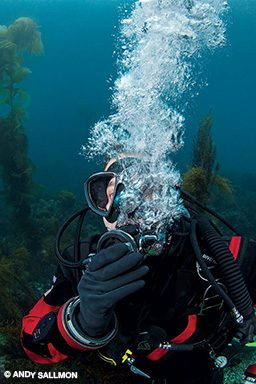In August 2016, I led a group of 12 divers on a recreational dive trip to Tobermory, Canada. Some of the divers were new to cold water, and some were seasoned cold-water divers, but they all were ready for three days of diving the 1800s shipwrecks for which the area is known. I had led trips here before and was excited to share these sites with a new group.

The trip began with a dive briefing from Captain Tom, who led with some jokes before telling us how the ship we were about to dive was sunk on purpose for recreational divers, which explains why divers can see much of the ship at a depth of just 50 feet. Experienced divers can drop down to 103 feet to see the stern. Having previously dived this site a few times, I knew where all the fun parts were. My plan to navigate the wreck was to start at the bow and work my way across and over the shipwreck to the stern and then end the dive with a slow climb back to the bowline.
As my wife and I were getting set up, the rest of the group paired up. One diver, who was a new cold-water diver, paired up with two of his friends who already had a few cold-water dives under their weight belts. The captain soon dropped the ladder and said, “The pool is open.” My wife and I were last off the boat because I like to help divers who need assistance getting in the water.
We descended and followed our planned route to the bow and then moved toward the stern. We saw part of our group on the wreck, and everyone looked like they were having fun exploring the ship and keeping warm as best they could. My computer recorded the water temperature as 41°F at depth as I watched over the divers who had reduced bottom times due to their 7 mm wetsuits not providing much protection from the cold water, unlike my drysuit.
After spending 28 minutes on the wreck, my wife and I slowly made our way up the bowline for our safety stop. When we arrived on the surface, the other divers were already on the boat. As we were getting on board, Captain Tom said, “Not to alarm you, but I have one diver on oxygen.”
I thought the captain was joking again, but I soon realized it was no joke. I immediately checked on the diver, who looked panicked and was breathing heavily from an oxygen mask. It was the new cold-water diver who had dived with his two friends. The captain told me that the trio surfaced within five minutes of entering the water and had reached a maximum depth of 103 feet, according to their dive computers. He said he saw a lot of bubbles come to the surface before the divers returned.
I calmly asked the diver what had happened. He was a little shaken up but wasn’t as bad as I expected for someone with a possible dive injury. He said that his group had dropped straight down to the stern of the ship, and at 103 feet his regulator free flowed. Being in cold water surrounded by bubbles was disorienting, but he remembered he could still breathe off his regulator. When his two buddies noticed the problem, they grabbed him and began to ascend, possibly exceeding 30 feet per minute.
At a depth of about 50 feet, the diver’s tank was empty. He signaled to his buddy that he was out of air, and the buddy offered his spare regulator. They ascended to 15 feet, where the diver was calm enough to attempt a safety stop, but they didn’t stay for the full three minutes. When the divers returned to the boat and told the captain what happened, the diver was shaking and breathing hard, so the captain decided to administer oxygen. It took a while to calm the diver, who was scared and hyperventilating.

As soon as I heard his story, I called the DAN® Emergency Hotline. I have been a DAN member for 12 years and had my card in my dive bag. I told the person who answered the call that I was with a diver who possibly had an arterial gas embolism and asked if someone at DAN could help me perform a neurological exam. They immediately transferred me to a DAN medic, who listened to my retelling of the incident and asked to speak with the diver.
She asked the diver yes or no questions for a couple of minutes, and then he handed the phone back to me. The DAN medic directed me to ask the diver to do things such as “follow my finger with your eyes” and “lift both arms out like a zombie,” and I reported back my observations. The DAN medic coached me through my first nonsimulated neurological exam, which I performed exactly as I had been trained in my divemaster class. After the exam was over, the DAN medic talked to the diver and determined that his symptoms did not warrant an emergency evacuation. DAN advised him to cease diving for the rest of the day and to refrain from diving the next day as well to be safe. The medic gave me a list of things to watch for and told me to seek advanced medical care for the diver if I noticed any of those symptoms.
We made sure to go over free-flow procedures in every dive briefing from then on. The diver recovered while sitting out for five dives but completed the last two dives of the trip without problems. Fortunately, this situation ended on a positive note. DAN was there when we needed them; I am thankful they were just a phone call away.
© Alert Diver — Q3 Summer 2019